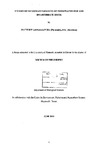STUDIES ON MYXOZOAN PARASITES OF FRESHWATER FISH AND INVERTEBRATE HOSTS
| dc.contributor.author | LONGSHAW, MATTHEW | |
| dc.contributor.other | Faculty of Science and Engineering | en_US |
| dc.date.accessioned | 2013-11-04T12:54:41Z | |
| dc.date.available | 2013-11-04T12:54:41Z | |
| dc.date.issued | 2004 | |
| dc.identifier | NOT AVAILABLE | en_US |
| dc.identifier.uri | http://hdl.handle.net/10026.1/2566 | |
| dc.description.abstract |
A study of myxozoan parasites has been investigated in hosts from freshwater environments in the UK. Over 17,000 oligochaetes, almost 5,000 juvenile cyprinids representing 7 species and over 60 invertebrate species have been examined for the presence of myxozoan parasites. In addition, studies on the lifecycle of Tetracapsuloides bryosalmonae (the causative agent of salmonid proliferative kidney disease, PKD) and of selected cyprinid myxozoans were conducted. A total of 21 actinospore types in seven collective groups were isolated and described from oligochaetes collected from seven different river systems in England and Wales. Twelve of the actinospores isolated appear to be new to science. Differences were noted in types of actinospores released at different sites and between seasons. Most actinospores were released from oligochaetes in spring and summer with prevalence of release ranging from 0.11% up to 5.83%. The most common actinospores were members of the collective group Echinactinomyxon with seven types identified, followed by the collective group Triactinomyxon, of which 6 types were identified. Five actinospores types were each encountered only once during the study. In juvenile cyprinid fish, 14 identifiable species of myxozoans in the genera Myxidium, Myxobolus and Sphaerospora plus three developmental stages were detected by histological examination. The most common myxozoans in cyprinids were Myxobolus pseudodispar and Myxobolus pfeifferi. Roach contained the most number of myxozoan species. Only seven myxozoan species were found in chub, but pathological responses and intensity of infections, particularly with M. pseudodispar, M. pfeifferi and Myxobolus buckei were greater when compared to other cyprinids examined. Juvenile cyprinids only appear to mount a pathological response to myxozoans once sporogony is initiated and some of those responses were considered severe enough to be detrimental to host survival. Mathematical models were produced using parasite data and incorporating a variety of data, including fish length, year class strength and environmental data to attempt to demonstrate a population level effect of disease. Many of the models developed clearly show that parasitism by Myxobolus spp. and Bucephalus polymorphus in juvenile fish is strongly correlated with population success in selected UK rivers. Laboratory experiments to transmit Myxobolus spp., Myxidium spp. and Sphaerospora spp. from selected cyprinid hosts to oligochaetes were unsuccessful. The most likely explanation is that the genetic strain of Tubifex tubifex used in the trials was not susceptible to infections by the myxospores selected. Specific DNA primers for Tetracapsuloides bryosalmonae were used on samples of over 60 invertebrate species collected from sites enzootic for PKD and on all 21 actinospore types isolated during the current study. All PCR reactions were negative for the presence of T. bryosalmonae DNA. Naive rainbow trout exposed to T. bryosalmonae spores from naturally infected bryozoans by bath challenge for 10 minutes developed PKD. Intraperitoneal injection of spores failed to induce the disease. The favoured route of entry by the parasite appears to be through mucous cells in the skin epithelium. | en_US |
| dc.description.sponsorship | The Centre for Environment, Fisheries and Aquaculture Science, Weymouth, Dorset | en_US |
| dc.language.iso | en | en_US |
| dc.publisher | University of Plymouth | en_US |
| dc.title | STUDIES ON MYXOZOAN PARASITES OF FRESHWATER FISH AND INVERTEBRATE HOSTS | en_US |
| dc.type | Thesis | |
| plymouth.version | Full version: final and full version as approved by the examiners at the time of the award of your degree | en_US |
| dc.identifier.doi | http://dx.doi.org/10.24382/4669 |
Files in this item
This item appears in the following Collection(s)
-
01 Research Theses Main Collection
Research Theses Main


